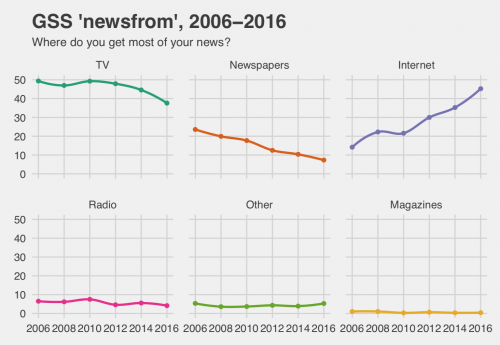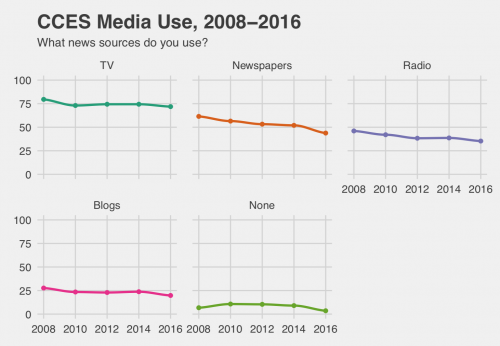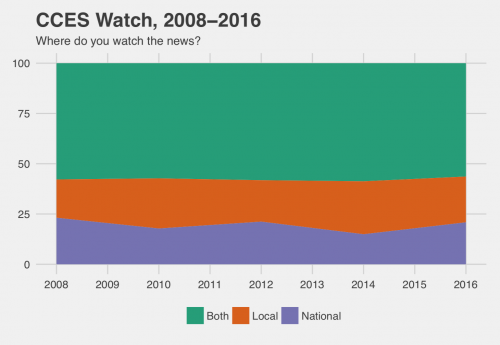The recent controversy about local news stations in the Sinclair Broadcasting Group reading a coordinated, nationwide message against “fake news” raises questions about the state of news consumption in the United States. Where are Americans getting their news from? If more people are reading the news online, did the Sinclair message have a large impact?
The General Social Survey asks respondents where they get most of their information about the news. This graph shows big changes in Americans’ primary news source, including the rise of online news and the decline of television and newspapers. Notably, in the 2016 GSS, the Internet overtook TV as Americans’ primary source of news for the first time.

Another survey, The Cooperative Congressional Election Survey, takes a different approach. They ask respondents to select whether they use newspapers, blogs, television, or other sources for their news information. When a survey doesn’t ask respondents to pick a primary source, we see that use rates are more steady over time as people still use a variety of sources.

Reported rates of news watching have also stayed pretty stable over the last eight years, with about three-quarters of Americans getting some of their news from TV. Of people who watch news on TV, many respondents report that they watch both local and national news, and this choice has stayed relatively stable over time. Since local news is still a steady part of our news diet, the Sinclair broadcast had a much broader potential reach than we would typically assume about news today.

Ryan Larson is a graduate student from the Department of Sociology, University of Minnesota – Twin Cities. He studies crime, punishment, and quantitative methodology. He is a member of the Graduate Editorial Board of The Society Pages, and his work has appeared in Poetics, Contexts, and Sociological Perspectives.
Evan Stewart is a Ph.D. candidate in sociology at the University of Minnesota. You can follow him on Twitter.
Andrew M. Lindner is an Associate Professor at Skidmore College. His research interests include media sociology, political sociology, and sociology of sport.
Inspired by demographic facts you should know cold, “What’s Trending?” is a post series at Sociological Images featuring quick looks at what’s up, what’s down, and what sociologists have to say about it.

Comments 4
A Reeves — April 17, 2018
interesting thoughts https://thesocietypages.org/
Melissa — April 9, 2019
Interested to see the statistics for 2018-2019 years. I think so many people watch TV nowadays. I'm not even sure that they mostly use smartphones as news source.perhaps most of us already perceive information vie virtual or augmented reality? And it won't be strange. So many VR/AR developers companies nowadays.
www.storeopinion.can — June 30, 2023
Hello Guys! I am the General manager of the Loblaws store, We providing a survey for our customer's feedback, In the part of the survey We decided to give a golden opportunity to our customers. By participating in the survey at StoreOpinion Ca
get a chance to win a $1000 Gift card.
Richard Patterson — June 19, 2024
Despite the transition from television to online news sources, the number of TV news viewers is still very large, showing that no matter the form, viewers are very interested in poppy playtime chapter 3.